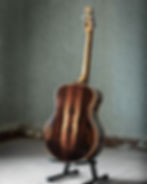Indonesian Hardwood Deep Dive: Uncovering the Perfect Wood for Your Project
- Azula Designs
- Aug 14, 2025
- 6 min read
Updated: Aug 14, 2025

Have you ever been captivated by a beautifully crafted piece of furniture, its rich tones and intricate details telling a silent story of the wood from which it was born? Often, the most exquisite and enduring pieces owe their character and longevity to the exceptional quality of Indonesian hardwood. Indonesia, with its diverse and abundant rainforests, is a treasure trove of remarkable hardwoods, each possessing unique characteristics that make them highly sought after by artisans, designers, and homeowners worldwide.
In this comprehensive guide, we will delve deeper into the fascinating world of Indonesian wood, exploring a wider range of popular and lesser-known species.
The Esteemed Lineup of Indonesian Hardwoods: Strength and Beauty Combined
When considering Indonesian hardwoods, certain species consistently stand out due to their exceptional durability, inherent beauty, and versatility. These woods are the backbone of fine furniture making and are renowned for their ability to withstand the test of time.
Teak (Tectona grandis)

Without a doubt, teak remains the most celebrated of all. Its global reputation for unparalleled durability and natural resistance to a multitude of threats, including rot, decay, termites, and harsh weather conditions, is well-earned. This remarkable resilience makes teak an ideal choice for both elegant indoor furniture that will become a family heirloom and robust outdoor furniture that can brave the elements for decades.
Beyond its strength, teak boasts a rich, golden-brown hue that deepens and develops a beautiful patina as it ages, further enhancing its allure. Its straight and consistent grain adds to its aesthetic appeal, making it a timeless classic.
Mahogany (Swietenia macrophylla)

Synonymous with sophistication and luxury, mahogany is another prized Indonesian hardwood. Its beautiful reddish-brown color, which matures into a deeper, richer tone over time, exudes warmth and elegance. Mahogany is not only visually appealing but also possesses excellent stability, resisting the common issues of swelling, warping, and shrinkage. This inherent stability, coupled with its relative ease of carving and finishing, makes it a favorite among cabinet makers and furniture designers creating high-end, long-lasting pieces.
Acacia (Acacia spp.)

For those seeking a harmonious blend of durability and affordability, acacia presents an excellent option. This versatile Indonesian hardwood has striking and often swirling grain patterns, showcasing a beautiful array of natural colors from light golden browns to richer, darker shades. Acacia is a strong and relatively hard wood, making it suitable for a wide range of applications, from solid-slab furniture with a rustic charm to durable flooring and smaller, unique decorative items. Its increasing popularity is a testament to its attractive appearance and reliable performance.
Unveiling the Unique and Precious Woods of Indonesia
Beyond the widely recognized species, the forests of Indonesia harbor a collection of truly exceptional and often highly valuable woods. These are frequently distinguished by their extraordinary beauty, unique physical properties, or rarity, making them prized possessions for those who appreciate the finer nuances of natural materials.
Indonesian Rosewood (Dalbergia latifolia)

Often referred to locally as Sonokeling, Indonesian rosewood stands out as one of the most expensive woods originating from the region. Its breathtaking color palette, ranging from deep, chocolate browns to rich purples, often adorned with dramatic black streaks, makes it instantly recognizable. This exquisite hardwood possesses a fine, tight grain that allows for a lustrous and smooth finish, making it a coveted material for crafting luxury furniture with intricate detailing, high-end musical instruments renowned for their tonal qualities, and delicate, artistic carvings that showcase its inherent beauty.
Ironwood (Eusideroxylon zwageri)
True to its name, ironwood, or Ulin as it is locally known, is an exceptionally dense and remarkably hard Indonesian hardwood. Its density is so significant that it sinks in water! This extreme density translates to unparalleled strength and exceptional resistance to decay, insect infestation (including termites), and the harsh effects of weathering.
Consequently, ironwood is the material of choice for heavy-duty construction in marine environments, durable outdoor decking that can withstand decades of exposure, and robust furniture designed to endure extreme conditions. Its natural durability often outweighs its workability challenges.
Suar Wood (Albizia saman)

Highly prized for its often massive size and incredibly dramatic and contrasting grain patterns, suar wood is a visually stunning wood from Bali and other parts of Indonesia. Characteristically featuring a lighter sapwood and a darker heartwood, the stark contrast creates unique and eye-catching figures, making it a popular choice for crafting single-slab dining tables, impressive statement pieces, and large-scale carvings.
While generally softer than some other Indonesian hardwoods, its impressive dimensions and captivating, two-toned aesthetic make it a favorite among designers and those seeking a truly unique and natural element in their spaces.
Navigating the World of Indonesian Wood Furniture
The skilled artisans of Indonesia have a long and rich tradition of working with these magnificent woods, transforming raw materials into stunning pieces of furniture and art. Whether you are exploring the vibrant markets of Bali in search of a unique handcrafted item or browsing online for a substantial piece of Indonesian wood furniture to enhance your home, you will encounter a diverse array of styles and craftsmanship.
When investing in Indonesian wood furniture, it is crucial to inquire about the specific type of Indonesian hardwood used in its construction.
Reputable sellers will provide clear information about the wood's origin, its inherent properties, and recommended care instructions. This transparency ensures that you are acquiring a genuine product that not only meets your aesthetic preferences but also offers the durability and longevity you expect from high-quality hardwood types.
Pro Tip: Contact Azula Designs to meet reputable furniture manufacturers from Indonesia. We've already done the homework!
Understanding Hardwood Characteristics: A Quick Guide
To further assist you in your selection process, here's a table summarizing some key characteristics of the Indonesian hardwoods discussed:
WOOD TYPE | JANKA HARDNESS | COLOR RANGE | GRAIN PATTERN | DURABILITY | USES | PRICE |
Teak | 1,000 - 1,155 lbf | Golden Brown (ages to silver) | Straight, sometimes wavy | Excellent | Indoor/Outdoor Furniture, Decking, Boatbuilding | High |
Mahogany | 800 - 900 lbf | Reddish-Brown (darkens with age) | Fine, Straight, Ribbon | Good | Fine Furniture, Veneer, Musical Instruments | Medium to High |
Acacia | 1,700 - 2,200 lbf | Light to Dark Brown, Gold | Variable, often swirling | Good | Furniture, Flooring, Bowls, Small Decorative Items | Medium |
Indonesian Rosewood | 1,780 lbf | Dark Brown to Purple with Black | Fine, Dense | Good | Luxury Furniture, Musical Instruments, Carvings | Very High |
Ironwood (Ulin) | >3,000 lbf | Dark Brown to Black | Fine, Interlocked | Excellent | Heavy Construction, Decking, Piers, Durable Furniture | High |
Suar Wood | 900 lbf (approx.) | Light Sapwood, Dark Heartwood | Dramatic, Irregular | Moderate | Slab Tables, Large Furniture, Decorative Pieces | Medium to High |
Note: Janka hardness is a measure of the resistance of wood to denting and wear. Higher numbers indicate a harder wood.
Frequently Asked Questions (FAQ) About Indonesian Wood
Q: What makes Indonesian wood so special?
A: Indonesian wood is highly valued due to the diverse range of hardwood species found in its tropical rainforests. These woods often possess exceptional durability, beautiful grain patterns, and unique color variations, making them ideal for high-quality furniture, construction, and decorative purposes. The skilled craftsmanship of Indonesian artisans also contributes significantly to the value and appeal of wood products from this region.
Q: Is all wood from Indonesia considered hardwood?
A: While Indonesia is famous for its hardwoods, it also has softwood species like Sumatran Pine. However, the term "Indonesian wood" and "woods of Indonesia" often refer to the sought-after hardwoods known for their strength and beauty, such as teak, mahogany, and rosewood.
Q: Which Indonesian wood is the most durable?
A: Ironwood (Ulin) is generally considered the most durable Indonesian hardwood due to its exceptional density and resistance to rot, insects, and wear. Teak is also renowned for its excellent durability, particularly against moisture and pests.
Q: What is the difference between Indonesian rosewood and other types of rosewood?
A: Indonesian rosewood (Dalbergia latifolia), also known as East Indian Rosewood or Sonokeling, is a specific species of rosewood with distinctive dark brown to purplish hues and black streaks. While other types of rosewood exist globally, Indonesian rosewood is highly prized for its unique coloration, fine grain, and acoustic properties, making it particularly valuable for musical instruments and luxury furniture.
Q: Is buying wood from Bali sustainable?
A: Sustainability is an important consideration when purchasing any wood product. When buying wood from Bali or other parts of Indonesia, inquire about the sourcing practices of the seller. Look for certifications or assurances that the wood has been harvested responsibly and legally. Supporting businesses that prioritize sustainable forestry helps protect Indonesia's valuable natural resources.
Q: How do I care for Indonesian hardwood furniture?
A: Care instructions vary depending on the specific type of Indonesian hardwood and the finish applied. Generally, regular dusting with a soft cloth and avoiding exposure to extreme temperatures and humidity are recommended. For finished furniture, read Azula Designs' guide for cleaning and maintenance. Oiling teak furniture periodically can help maintain its natural luster.
Conclusion
The world of Indonesian hardwood is rich and diverse, offering a spectrum of choices to suit any project and aesthetic preference. From the timeless elegance of teak and mahogany to the exotic beauty of Indonesian rosewood and the exceptional durability of ironwood, Indonesia's woods continue to captivate and inspire. By understanding the unique characteristics of these remarkable hardwood types, you can make informed decisions and appreciate the enduring quality and natural beauty of Indonesian wood for years to come. Whether you are drawn to the rustic charm of wood from Bali or the sophisticated appeal of Indonesian wood furniture, the legacy of these magnificent hardwoods is sure to enrich your life and surroundings.

